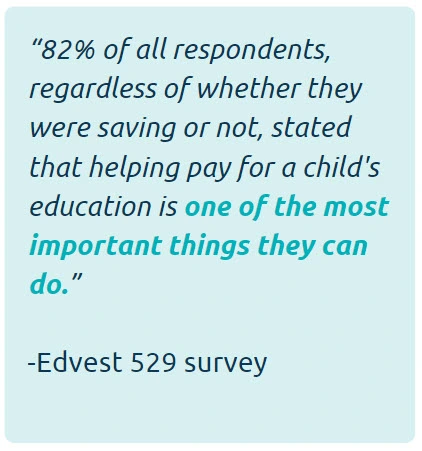Do Wisconsin Families Think Saving for College is Worth it?
Recent survey sheds light on college savings perceptions and habits
By: Chelsea Wunnicke, Wisconsin Department of Financial Institutions
published July 3, 2024

It is no secret that higher education can be expensive and that prices continue to rise. According to an analysis conducted by U.S. News, in the past 20 years adjusted for inflation, the annual cost of tuition and fees has increased by 40% for private National Universities, 38% for out-of-state public National Universities, and 56% for public National Universities.1 Despite these overwhelming numbers, over 113,000 Wisconsin 529 account owners continue to see the value in saving for their children’s future education, all while balancing other financial obligations and goals.2
This is why Edvest 529, Wisconsin’s direct-sold College Savings Plan, wanted to dive into the perceptions of people who are actively saving for college and people who are currently not. In their survey, Wisconsin families were asked to share their thoughts on the value of higher education, if they are saving for educational opportunities beyond high school, and how they choose to save.
The Perceived Value of College
Overwhelmingly, 82% of all respondents, regardless of whether they were saving or not, stated that helping pay for a child's education is one of the most important things they can do. Additionally, 72% said they worry their child will be overwhelmed with debt if they attend college.3
Despite the increasing concern over potential student loan debt, the Edvest 529 survey demonstrated that college continues to be a major milestone many hope to achieve. 78% of surveyed parents “really want (their) child to go to college.”3 This ideal is supported by national data from the U.S. Bureau of Labor Statistics, which shows that people with a bachelor's degree or advanced professional degree earn nearly $600 or $1,300 more per week, respectively, than those with only a high school diploma.4

So, this leads to the question - how are families saving for such a significant future expense?
How Wisconsin Families Are Saving for College
According to the survey results, Wisconsin families are strategically preparing for the cost of college by combining several tactics. Some strategies include:
- They are asking for extended family support. Although 66% of people expect to fund their education savings accounts themselves, over 44% of people plan to receive help from grandparents or other family members to contribute to their children's college savings plan. Additionally, 14% also plan to have the student themself contribute to their education savings.5
- They are planning for flexible post-secondary options. Parents are motivated to start saving due to the potentially high cost of college, with 73% stating “that college costs are most important in their decision to start saving.” However, 14% of respondents are motivated to save for post-secondary programs other than 4-year college, including pursuing an associate degree, career training, or an apprenticeship.5
- They are reducing taxes while saving. Wisconsin families surveyed say that two of the most important benefits of saving in an Edvest 529 College Savings Plan account are the potential to deduct contributions from Wisconsin state income tax and the opportunity for tax-free growth and distributions for qualified educational expenses.5
For parents who are not yet saving, many were not aware that 529 plans could be used at post-secondary institutions nationwide and even some abroad, not just those in Wisconsin. Also, they were unaware that funds saved in a 529 account do not need to be spent by a certain age.5
Funds not used for education are not forfeited; they can be transferred to a qualifying family member, saved to be used later, perhaps for graduate school, or rolled into a Roth IRA retirement account for the beneficiary, subject to criteria and limits.6
Resources for Higher Education Savings in Wisconsin
Families have access to several valuable resources to help them save for college effectively:
- Wisconsin Department of Financial Institutions: Click “Educational Services” to download the College & Career Readiness Guide in English and Spanish, along with resources on student loan borrowing and Wisconsin 529 College Savings Plans from the State of Wisconsin.
- Edvest 529 College Savings Plan: This college savings plan offers Wisconsin families triple tax benefits, diverse investment options, and flexibility in how funds can be used for education expenses. More information can be found on the Edvest 529 website, including videos, webinars, and calculator tools.
- Financial Aid Offices: Many colleges and universities have financial aid offices that provide resources and guidance on saving for college, securing scholarships, and understanding financial aid packages.
- Scholarship Databases: Websites like Fastweb, Scholarships.com, and the Wisconsin Higher Educational Aids Board offer extensive databases of scholarships and grants available to students.
- Financial Advisors: Consulting with a financial advisor can help families develop a comprehensive college savings plan tailored to their specific needs and financial situation.
- Online Resources and Tools: Websites like Savingforcollege.com, the College Savings Plan Network (CSPN), and College Savings Foundation (CSF), offer calculators, articles, and resources to help families understand their college savings options and make informed decisions.
Even with the rising costs of higher education, Wisconsin families surveyed continue to perceive that the value of post-secondary education is strong. By utilizing a variety of savings strategies and taking advantage of available resources, they are preparing to support their children's educational aspirations. They understand that to reduce future reliance on student loan debt, they should start to save early, save consistently, and seek out resources on the best ways to invest in their children’s future.
About Chelsea:
Chelsea Wunnicke serves as a Wisconsin College Savings Program Finance Officer with the Wisconsin Department of Financial Institutions. With a background in delivering Financial Capabilities Outreach and Education, Chelsea has a special interest in helping more Wisconsin communities and youth benefit from early saving for higher education. She lives with her family in rural Richland County, Wisconsin.

###
To learn more about Wisconsin's Edvest 529 College Savings Plan, its investment objectives, risks, charges and expenses see the Plan Description at Edvest.com. Read it carefully. Wisconsin taxpayers can qualify for a 2024 state tax deduction up to $5,000 annually per beneficiary, for single filer or married couple filing a joint return, from contributions made into an Edvest 529 College Savings Plan. Married couples filing separately may each claim a maximum of $2,500. Investments in the Plan are neither insured nor guaranteed, and there is the risk of investment loss. Prior to investing, check with your home state to learn if it offers tax or other benefits such as financial aid, scholarship funds or protection from creditors for investing in its own 529 plan. If the funds aren't used for qualified higher education expenses, a federal 10% penalty tax on earnings (as well as federal and state income taxes) may apply. Consult your legal or tax professional for tax advice. TIAA-CREF Individual & Institutional Services, LLC, Member FINRA, distributor and underwriter for the Edvest 529 College Savings Plan.
Neither TIAA-CREF Tuition Financing, Inc., nor its affiliates, are responsible for the content found on any external website links contained herein.
Sources
- 1Source: U.S. News; A Look at 20 Years of Tuition Costs at National Universities, Sept. 22, 2023. See 20 Years of Tuition Growth at National Universities (usnews.com)↩
- 2Data from Edvest 529 College Savings Plan as of 3/31/2024.↩
- 3Edvest 529 College Savings Plan survey, Education Attitudes, an average of all survey respondents, 2023↩
- 4Source: U.S. Bureau of Labor Statistics, Employment Projections: Education Pays Education pays, 2023: Career Outlook: U.S. Bureau of Labor Statistics (bls.gov) median weekly earnings for workers with an advanced professional degree in 2023 ($2,206), with a bachelor’s degree ($1,493), and with a high school degree ($899).↩
- 5Edvest 529 College Savings Plan survey; Sources of Funds Importance: Who Will Contribute, an average of all survey respondents, 2023↩
- 6Funds rolled over to a Roth IRA can be withdrawn free from federal and Wisconsin income tax. If you are not a Wisconsin taxpayer, these withdrawals may include recapture of tax deduction and state income tax. Account Owners and Beneficiaries should consult with a qualified tax professional before rolling over funds from their 529 plan to contribute to a Roth IRA.↩
FGN-3671258CR-Y0724W
More to explore
-
Explore our plan
Learn more about eligibility and all the qualifying expenses an Edvest 529 account can cover.
How our 529 works -
Compare investment portfolios
We make it easy to choose investment portfolios that fit your financial needs and savings goals.
Discover your options -
Ready to get started?
Open an Account